Why Go There?
For me, it’s personal. My birthplace, my motherland, Hungary holds so many memories for me and so much family history. Even though I was only three when I left this place, it haunts me, pulls me back, and I want to be a part of the new vibrant Hungary.
This new Hungary shows in the faces of old and young. They smile more, they talk to each other. I’ve seen more babies and young children this trip than I have ever before. And the children are so well behaved its positively refreshing to not have to deal with crying screaming children! The economy is good here, people have good jobs and are starting companies and are happy so they are bringing new lives into the world. This is good news for Hungary whose population has been stagnant for over 50 years.
For others, the culture, the history, the food and artwork, the museums, and hand made goods offer something for everyone looking for adventure and unique products.
How to Get There
An exhausting trip from Reno, Nevada to Budapest, Hungary took over 20 hours by plane.
We left Reno early Sunday morning on April 8 and arrived in Budapest on April 9 late afternoon. Our flight was delayed out of Heathrow Airport in London due to a delayed inbound airplane. Finally around 1:30pm (our flight was supposed to depart at 12:55pm) we left London and began our short flight plus two hours to Budapest. We were supposed to arrive around 4:30pm but didn’t arrive until 5:15pm. Getting off the plane, securing a wheel chair for hubby took 15 minutes or so. Then after gaining approval to enter the country (by way of a stamp on our passports) and waiting to collect our luggage, we finally met our taxi driver around 6pm. He had been waiting for us since 4:30pm. A long taxi ride from the airport (on the Pest side of the Danube river) took us through the working class neighborhoods of Pest. Once we crossed the Danube and continued our trek to our hotel on the Buda side, the neighborhoods improved in architecture and clientele dramatically.
Recently American Airlines opened up a new route to Hungary through Philadelphia, thereby avoiding Heathrow altogether. This change has made the trip less tedious, a bit more streamlined, and less reliant on the tiresome security protocols at the London airport.
Timing of Your Visit
If you are like me and don’t like dodging a bazillion tourists while vacationing, look for a time of year when tourism is lower. In Hungary, April 2018 seems to be a particularly busy time with peoples from all parts of the world: China, Japan, France, Italy, Germany, Spain, Portugal, Britain, Russia, Australia and America; all trying to experience the sites, sounds, and historic locations of this country. Also do your research into what events are happening at what time of year that might attract a lot of tourists. March 30 – April 22, 2018 turns out to be the Spring Festival here in Hungary. The festival boasts events and concerts daily and attracts people from all over the world. Hence the huge population of tourists here now.
Oct. 23, 1956 was the start of the Hungarian Revolution and the beginning of the end of Communist rule in Hungary. It would take 30+ years to wrest this stranglehold from my mother country. We timed our visit to coincide with this historic holiday in 2018 but really came to celebrate my aunt and Godmother’s 94thbirthday on Oct. 25. As a national holiday, all shops were closed for this day.
I was there on that fateful day back in 1956, clutching the hand of my mother as a precocious three year old, looking very grown up in my hand me down coat from one of my many cousins. I had no idea what was going on but my mother certainly knew that the population, led by the university students, had had enough of communist rule where the population is equal to have nothing while the Communist elites hoard the food and keep the best of everything for themselves. Other peoples’ misery created the wealth for the upper echelons of communist hierarchy.
Currency
Hungarian currency, called forint, is favorable to the US dollar. While their economy is improving, their currency has lost some value. In other words, your US dollar, Euro or British Sterling will buy you more goods at this time than a year ago.
History
Hungary is a country with over a thousand years of history visible in the amazing old buildings in the capital city of Budapest and historic castles and mansions around the country. The rapid transit system of cable cars, underground metro, and buses is outstanding here so much so that you do not need a car if you are staying in the capital city. The metro will even take you way out of the capital city too. The Var, or Castle District, is particularly popular with tourists because of the Buda Castle, Fisherman’s Bastion, Mattyas Templom (Mathias Church) and the shops and many delicious restaurants.
The Castle District has become the most expensive neighborhood in Budapest if you want to live here or buy a flat. I used to live in #12 on Uri Utca (Street).
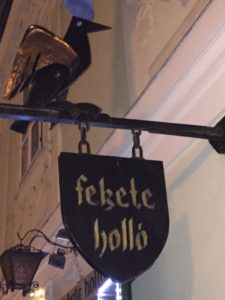
Black Raven Restaurant
A couple of really good restaurants we’ve enjoyed in the Castle District are the Fekete Hollo or Black Raven on Országház. utca 10 and St. George’s Hotel & Restaurant on Fortuna u. 4.
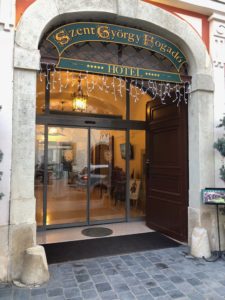
St George Hotel and Restaurant
Both restaurants have delicious Hungarian meals and excellent service.
Be aware that restaurants may include service charges (also called tips) into the final bill. If you find the service and the food to be exceptional, you can add an additional tip to your bill. Your wait staff will be ecstatic!
Make sure you have change when you go out and about the city. All public toilets require payment anywhere from 100 Forint to 200 Forint.
Best Shopping Locations
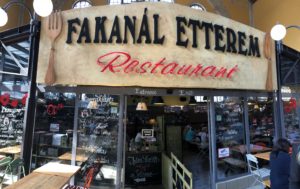
Fakanal Restaurant inside Csarnok
A popular location for shopping is the enormous brick building known as the Nagy Csarnok (Great Market Hall), built in 1896, at the end of Vaci Utca across the cable car tracks. Vaci Utca is a popular shopping street with tourists and is expensive. The Csarnok, on the other hand, is a cornucopia of goods from Hungarian liquors to Ajka glassware to fresh paprika (both sweet and spicy) and goose liver. Meats of all shapes and varieties are everywhere. Also you will find beautifully embroidered table runners, tablecloths and clothing as well as hand knitted sweaters for children. You will also find leather goods such as wallets, luggage, and purses in the aisles and various floors of the Csarnok. A number of restaurants and eating places are available inside serving traditional Hungarian fare like this one and popular fast food like langos (fried bread) onto which you can add a variety of cheeses and vegetables like on top of pizza.
As you travel the length and breadth of the Csarnok, the same goods you found at the front of the building become less expensive as you travel to the end and the side aisles due to less traffic there. Survey the entire building before you start buying anything if you are interested in getting the best price for goods purchased.
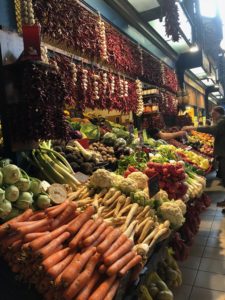
Fresh vegetables
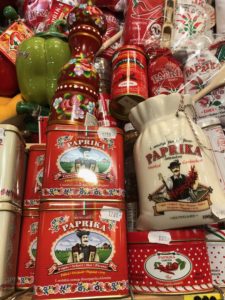
Hungarian Paprika
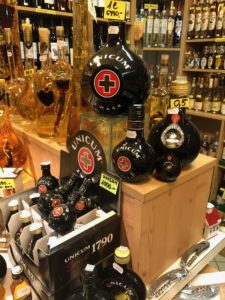
Hungarian aperitifs and liquors
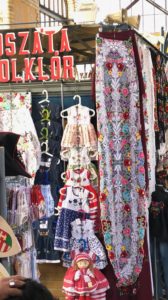
Embroidered table runners, children’s clothing and toys
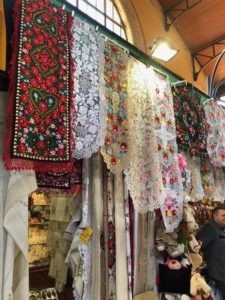
More beautiful table runners
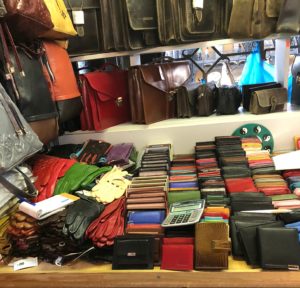
Leather goods
Let’s finish off with a disclaimer.
We have no relationship with any of the establishments or productions mentioned in this article. They are simply places we visited or stayed or reflected on or enjoyed during our self funded travels. We share them with our readers for informational/editorial purposes.
